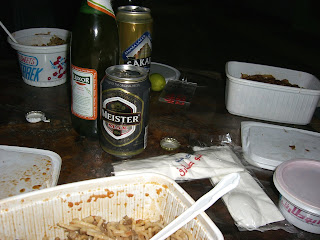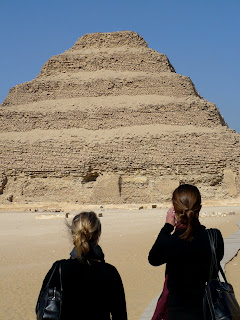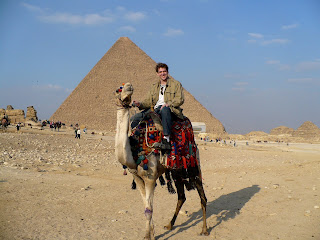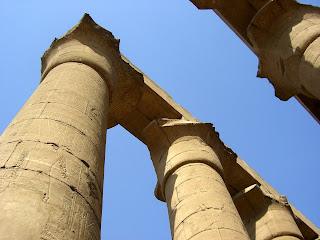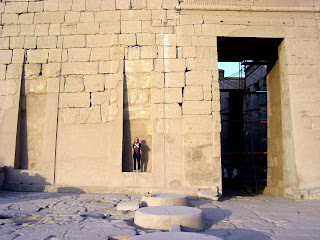Friday morning, we hired a car and a private guide to take us to the
West Bank of
Luxor, where many of the tombs and temples that
Luxor is famous for are located.
We were approached by a fellow American, Franceso Dominick Arbolino (no really, he
was American
!) who asked if he could join us on our tour.
He seemed fun enough, so we gladly agreed because it meant we saved five Egyptian pounds each ($0.80) on the tour, and hey, we’re all about living cheaply!
First stop was Valley of the Kings, which is, according to Lonely Planet, “A place of death, where nothing grows on its scorching cliffs.” Here we visited the tombs of Ramses IX, Ramses II, Seti II, and of course, the newly opened tomb of King Tutankhamun – King Tut! Unfortunately, no photography was allowed inside the tombs, but they were gorgeous with floor to ceiling painting of hieroglyphics and murals depicting the ruler’s lives. King Tut’s mummy, coffin and sarcophagus were also on display in his tomb – we were surprised as to how small he was!

We also visited Deira Al-Bahria, a temple built by Hatshepsut, the only female Pharo(ess) of Egypt.

Medinat Habu is a huge temple built by three pharos to glorify the god Amun.


Last was the disappointing Colossi of Memnon, which was covered in scaffolding and falling apart. They used to be part of a huge temple bigger even than Karnak but it was all destroyed a long time ago (27 B.C.) by an earthquake.

After lunch we did a bit of shopping at the Luxor souk. The shop owners enjoyed giving Francesco a hard time, telling him how lucky he was to have two wives (Eva and I) and offering to buy us in exchange for camels or chickens. He put up with the attention good naturedly, replying, “They are lucky to be with me!”
We ate dinner at a 1920’s-style international cuisine restaurant because we’re getting a little sick of the local food we’ve been having. Eva had soup and potato salad, Francesco had a burger and French fries and I had an omelet with a side of bacon – made with real pork! It’s funny that I rarely eat pork at home, but because it’s so hard to find here I’ve been craving it for days!
After dinner we found a sheesha place in the souk that promised us good quality Egyptian molasses tobacco and enjoyed sitting outside people watching and sipping Karkaday, a traditional drink infused with hibiscus flowers.




This morning, we hired another taxi to get back to the west bank and saw Tombs of the Nobles, Valley of the Queens, and the Ramesseum. My favorite part was the stunning tomb of Sennofer, which had a ceiling painted with vibrant grape vines and leaves.




While visiting the Tombs of the Nobles, we were told that George Bush is also in Egypt right now, who knew? He’ll be in Cairo when we are on some sort of Middle East tour bonanza.
On the way back, our cab driver stopped at a sugarcane field and grabbed us seven huge stalks of sugarcane. Because he was parked alongside the road, the police came and started questioning us, but luckily Eva and I were able to use our charm to keep us from getting in to any trouble. The situation ended with the police helping peel my sugarcane for me and taking pictures for us:

Tonight, Francesco and I convinced Eva (by paying for her meal) to have dinner at the vegetarian-unfriendly Japanese restaurant in St. George’s Hotel, Miyako. It was definitely pricey and the quality of the sushi wasn’t amazing, but all things considered it was good enough to satisfy the craving for sushi that I’ve had since we ate it last in Dubai. For dessert, I had a slightly disturbing looking white and chocolate mousse dish in the shape of a swan:

Right now Eva and I are on an overnight sleeper train to head to Cairo for our last four days! Things are winding down and we’re starting to come to terms with the fact that we’ll be back in the awful Wisconsin snow all too soon.








